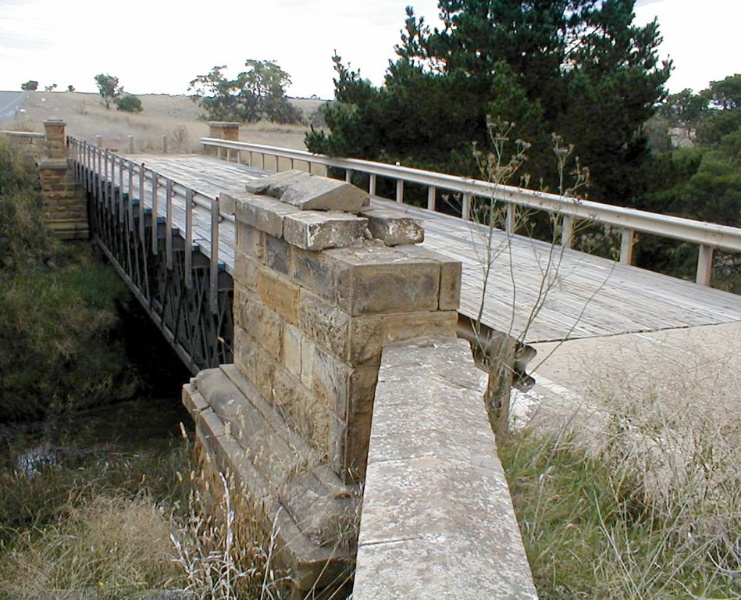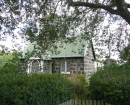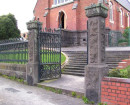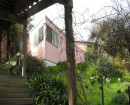Back to search results
McMillans Bridge
Mt Misery Creek crossing of Rokewood-Skipton Road,, ROKEWOOD VIC 3330 - Property No B7004
McMillans Bridge
Mt Misery Creek crossing of Rokewood-Skipton Road,, ROKEWOOD VIC 3330 - Property No B7004
All information on this page is maintained by National Trust.
Click below for their website and contact details.
National Trust
-
Add to tour
You must log in to do that.
-
Share
-
Shortlist place
You must log in to do that.
- Download report

B7004 McMillans Bridge


On this page:
Statement of Significance
McMillan's Bridge, originally built in 1856 by the Central Road Board to the design of Charles Rowland and incorporating 1888-9 modifications by the Shires of Leigh and Grenville to the design of Charles A.C. Wilson, is of scientific, aesthetic and historical significance at a State level.
It is notable technically as one of Victoria's earliest surviving examples of composite road-bridge construction, combining an unusual but aesthetically pleasing mixture of sandstone masonry abutments, riveted wrought-iron lattice-truss girders (forming a single main span of 29 metres or 95 feet) and a longitudinally planked timber deck (7.3 metres or 24 feet wide). The red sandstone abutments of 1856 are very rare examples of superior goldrush masonry bridge abutments, constructed according to an old European tradition. By contrast, when they were added in 1888 the extremely light but efficient wrought-iron trusses of the current bridge were of advanced design, and drew heavily upon the scientific theory and testing facilities of Professor W. C. Kernot's Department of Engineering at the University of Melbourne. The current McMillan's bridge represents an important step in the local evolution of wrought-iron trusses for use in bridge construction. By significantly decreasing the weight of lengthy and cumbersome truss components, considerable economies were achieved both in terms of materials and of construction costs, and iron bridge superstructures became more competitive with traditional hardwood alternatives.
Aesthetically, McMillan's Bridge is significant particularly for its superb sandstone masonry abutments, which support the later neat wrought-iron superstructure elements. The masonry abutments and wing walls feature coursed rusticated stone work, with finely worked string courses and an ornate stepped profile. The design of these historic and substantial masonry abutments is quite distinct from that of other colonial Victorian masonry structures, and possibly reflects the style of Telford, Brunel and early nineteenth-century British engineers who influenced David Lennox and in turn his pupil, Charles Rowland. Though two sandstone arch bridges dating from 1859 still survive in Victoria, sandstone was a far less common bridge-building material than the more durable basalt or bluestone.
McMillan's Bridge is also of considerable historical importance. Charles Rowland designed the unusual masonry abutments for a substantial composite bridge of 1856, built by Victoria's short-lived Central Road Board, which places them among our very earliest surviving examples of Victorian bridge technology. Very few detached stone-masonry road-bridge abutments (as distinct from integrated masonry arches) of the 1850s goldrush era are known to exist in Victoria. Most of our extant rural examples of such stone masonry abutments for big composite road bridges post-date the freak state-wide floods of 1870, which forced a major reconsideration of rural bridge technology and encouraged more high-level structures. Surviving elements from Central Road Board bridges of any type are extremely rare today. The early date of the bridge is indicative of the importance of the road as an early trunk route, both to the Western District squatters, and between Geelong and goldfields at Ararat and Streatham in the 1850s.
The current wrought-iron superstructure elements of 1888-9 represent a very different era in Victorian road and bridge development, when the State had off-loaded the main responsibility for maintaining Victoria's main road infrastructure to newly instituted rural municipalities which proliferated after 1870. The original main road bridge had been wholly designed and built by the State road authority, at State expense, but only 25% of the 1888 reconstruction cost was met by the State. The adjoining Shires of Leigh and Grenville contributed most of the cost from local rates revenues, for a locally-designed superstructure constructed by a Geelong engineering firm.
Classified: 02/08/1999
It is notable technically as one of Victoria's earliest surviving examples of composite road-bridge construction, combining an unusual but aesthetically pleasing mixture of sandstone masonry abutments, riveted wrought-iron lattice-truss girders (forming a single main span of 29 metres or 95 feet) and a longitudinally planked timber deck (7.3 metres or 24 feet wide). The red sandstone abutments of 1856 are very rare examples of superior goldrush masonry bridge abutments, constructed according to an old European tradition. By contrast, when they were added in 1888 the extremely light but efficient wrought-iron trusses of the current bridge were of advanced design, and drew heavily upon the scientific theory and testing facilities of Professor W. C. Kernot's Department of Engineering at the University of Melbourne. The current McMillan's bridge represents an important step in the local evolution of wrought-iron trusses for use in bridge construction. By significantly decreasing the weight of lengthy and cumbersome truss components, considerable economies were achieved both in terms of materials and of construction costs, and iron bridge superstructures became more competitive with traditional hardwood alternatives.
Aesthetically, McMillan's Bridge is significant particularly for its superb sandstone masonry abutments, which support the later neat wrought-iron superstructure elements. The masonry abutments and wing walls feature coursed rusticated stone work, with finely worked string courses and an ornate stepped profile. The design of these historic and substantial masonry abutments is quite distinct from that of other colonial Victorian masonry structures, and possibly reflects the style of Telford, Brunel and early nineteenth-century British engineers who influenced David Lennox and in turn his pupil, Charles Rowland. Though two sandstone arch bridges dating from 1859 still survive in Victoria, sandstone was a far less common bridge-building material than the more durable basalt or bluestone.
McMillan's Bridge is also of considerable historical importance. Charles Rowland designed the unusual masonry abutments for a substantial composite bridge of 1856, built by Victoria's short-lived Central Road Board, which places them among our very earliest surviving examples of Victorian bridge technology. Very few detached stone-masonry road-bridge abutments (as distinct from integrated masonry arches) of the 1850s goldrush era are known to exist in Victoria. Most of our extant rural examples of such stone masonry abutments for big composite road bridges post-date the freak state-wide floods of 1870, which forced a major reconsideration of rural bridge technology and encouraged more high-level structures. Surviving elements from Central Road Board bridges of any type are extremely rare today. The early date of the bridge is indicative of the importance of the road as an early trunk route, both to the Western District squatters, and between Geelong and goldfields at Ararat and Streatham in the 1850s.
The current wrought-iron superstructure elements of 1888-9 represent a very different era in Victorian road and bridge development, when the State had off-loaded the main responsibility for maintaining Victoria's main road infrastructure to newly instituted rural municipalities which proliferated after 1870. The original main road bridge had been wholly designed and built by the State road authority, at State expense, but only 25% of the 1888 reconstruction cost was met by the State. The adjoining Shires of Leigh and Grenville contributed most of the cost from local rates revenues, for a locally-designed superstructure constructed by a Geelong engineering firm.
Classified: 02/08/1999
Show more
Show less
-
-
-
-
MCMILLANS BRIDGE
 Victorian Heritage Register H1847
Victorian Heritage Register H1847 -
WESTERN CREEK GRAND JUNCTION CO
 Victorian Heritage Inventory
Victorian Heritage Inventory -
McMillans Bridge
 National Trust H1847
National Trust H1847
-
-








